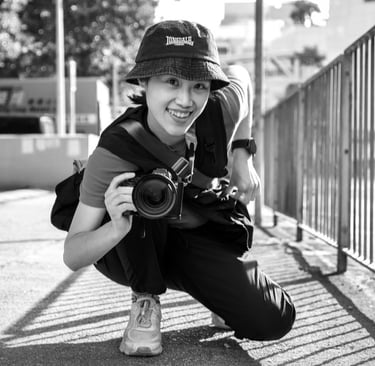A Guide for Non-Photographers: How to Truly See and Capture Meaningful Street Photos
In a world where everyone carries a camera in their pocket, it’s easy to fall into the trap of taking countless snapshots—images that often don’t hold much meaning or impact. But there’s a distinct difference between simply clicking the shutter and creating an image that truly resonates. Photography, at its core, is about seeing—observing the world around you in a more intentional, thoughtful way. If you’re new to photography or find yourself struggling to move beyond random snapshots, this guide will help you cultivate the skills to create meaningful, compelling photographs.
1. The Importance of Observation: Slow Down and Look
The first step in transforming your photography is learning to slow down and observe your surroundings. Most non-photographers tend to rush through taking pictures, snapping away without really considering what they’re photographing. Great photos, however, often come from patience and observation.
Tip: Before you take any photos, take a few moments to look around. What do you notice? Pay attention to light, shadows, shapes, and movements. The more you observe, the more likely you are to notice those unique moments that make for great photographs.
Exercise: Spend 10 minutes in one spot without your camera. Watch how people move, how light changes, and how small details emerge. Afterward, try to capture a single photo that reflects something meaningful you observed.
2. Start with a Story: Focus on Emotion and Intent
Photographs that stand out usually tell a story or evoke an emotion. They convey a message, whether it’s about joy, loneliness, tension, or serenity. Before taking a photo, ask yourself: What story am I trying to tell? What feeling do I want to capture? This will help you approach your photos with purpose.
Tip: Don’t just shoot whatever is in front of you. Instead, think about what the scene or subject represents and how you want to convey that to your viewer.
Exercise: Choose a theme for your photoshoot—such as “happiness” or “solitude.” Look for moments or scenes that visually express that theme and capture them thoughtfully.
3. Mastering Composition: Arranging Elements Within the Frame
Composition is the foundation of a great photograph. It’s about how you arrange the elements within your frame to create a visually appealing and balanced image. There are a few simple composition techniques that can significantly improve your photography:
Rule of Thirds: Divide your frame into nine equal parts using two horizontal and two vertical lines. Try placing your subject along these lines or at their intersections, rather than in the center of the frame. This creates more dynamic and interesting compositions.
Leading Lines: Use natural lines in the environment—like roads, fences, or rivers—to guide the viewer’s eye through the image and toward the main subject.
Framing: Look for elements in the scene that can act as a natural frame around your subject, such as archways, windows, or branches. This helps draw attention to the subject and adds depth to the image.
Exercise: Practice using the rule of thirds by taking photos where the main subject is positioned along one of the grid lines. Review your shots and see how this simple shift in composition changes the overall impact of the image.
4. Understanding Light: The Key to Great Photos
Light is one of the most critical elements in photography. How light interacts with your subject can completely change the mood and feeling of a photo. Understanding different types of light and how to use them will make your photos much more compelling.
Golden Hour: The soft, warm light during sunrise or sunset creates beautiful, flattering lighting for most scenes. This is often the best time to take photos.
Harsh Light vs. Soft Light: Harsh midday sunlight can create strong shadows and highlights, which can be unflattering or difficult to work with. Soft light, such as on an overcast day or in shaded areas, tends to be more forgiving and evenly lights your subject.
Backlighting: Shooting with the light source behind your subject can create dramatic silhouettes or glowing effects, depending on how you expose the photo.
Exercise: Take photos at different times of the day to see how the light changes the look and feel of the scene. Try shooting in direct sunlight, shade, and during the golden hour to get a sense of how light affects your images.
5. Simplify Your Photos: Less is More
One common mistake that non-photographers make is trying to include too much in a single photo. This can result in a cluttered image that lacks focus. Instead, aim to simplify your compositions by focusing on just one subject or element in the scene. Ask yourself: What is the most important part of this scene? Then eliminate anything that doesn’t contribute to that main subject.
Tip: Clean backgrounds or the use of negative space can help highlight your subject and create a stronger visual impact.
Exercise: Practice minimalism by photographing only one subject at a time. Find a simple background or a perspective that isolates the subject, and eliminate any distractions from the frame.
6. Look for Patterns, Textures, and Details
Great photography often lies in the details. Once you’ve developed an eye for observation, you’ll start noticing patterns, textures, and small details that can make for interesting photos. Whether it’s the repeating lines of a staircase, the texture of old brickwork, or the intricate details of a flower, these elements can add depth and interest to your images.
Tip: Get close to your subject and fill the frame with details. This can create a more intimate and compelling image.
Exercise: Go on a “pattern hunt.” Find and photograph patterns, textures, or small details in your surroundings that you might have overlooked before. Focus on filling the frame with these elements.


7. The Art of Patience: Wait for the Right Moment
Great street and candid photography often requires patience. Sometimes, the perfect moment doesn’t happen right away. Instead of clicking the shutter impulsively, learn to wait for the right moment to unfold. Whether it’s waiting for the right light, an interesting expression, or a perfect interaction between people, patience can lead to more powerful images.
Tip: Find an interesting location and stay there for a while. Observe how people move through the scene, how light changes, and what details emerge. When the right moment presents itself, you’ll be ready to capture it.
Exercise: Choose a spot and spend at least 15 minutes there, watching and waiting for something interesting to happen. Capture the moment when it feels right.
8. Review and Reflect: Learning from Your Photos
After you’ve taken photos, it’s important to review them with a critical eye. Instead of focusing on quantity, focus on quality. Look at each photo and ask yourself what works and what doesn’t. Are there distracting elements in the frame? Could the composition be stronger? Is the subject clear and compelling?
Tip: Don’t be afraid to delete photos that don’t work. This will help you refine your eye and learn from your mistakes.
Exercise: After a photoshoot, choose five of your favorite images and five that didn’t work as well. Analyze what makes the good photos strong and what could be improved in the weaker ones. Over time, this practice will help you become more intentional with your photography.
9. Experiment and Break the Rules
Once you’ve mastered the basics of composition, light, and storytelling, don’t be afraid to break the rules. Photography is an art, and sometimes the most interesting images come from experimentation and stepping outside the conventional guidelines. Try new angles, play with unusual compositions, or experiment with creative techniques like long exposures or motion blur.
Tip: The key is to experiment with intention. Break the rules when it serves your creative vision or helps you tell a better story.
Exercise: Choose one compositional or technical rule (such as the rule of thirds) and intentionally break it in a creative way. Experiment with different techniques to see what new and interesting results you can achieve.
Conclusion: From Snaps to Thoughtful Photography
The journey from taking random snapshots to creating meaningful street photographs is about learning to see the world with a photographer’s eye. It requires slowing down, observing, and thinking intentionally about what you want to capture. By focusing on composition, light, and storytelling, you can transform your photos from simple clicks into compelling images that resonate with viewers.
Photography is a skill that can be developed with practice and patience. Keep experimenting, keep observing, and most importantly, keep enjoying the process. With time, you’ll find that you’re no longer just taking pictures—you’re capturing moments and stories that truly matter.
Copyright © 2025 Peter Pickering. All Rights Reserved. All Wrongs Reversed.
🌐 peterpickering.com | 🎺 sessionsonthegreen.com | 💜 isaacbcole.com | ▶️ YouTube Channel | 🌿 life.peterpickering.com


